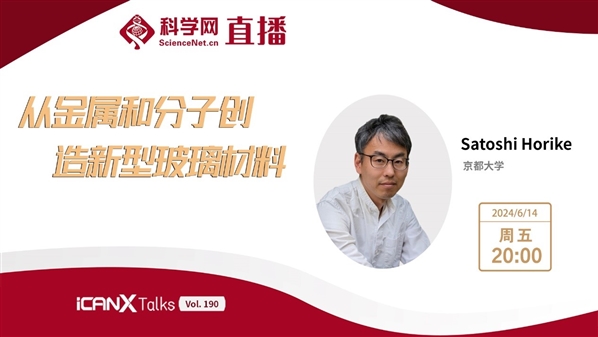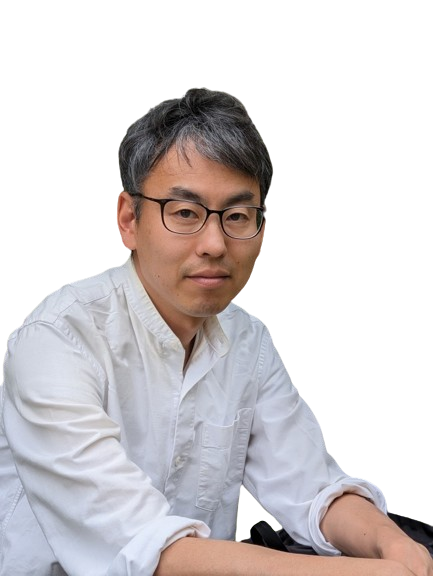
直播时间:2024年6月14日(周五)20:00-21:30
直播平台:

科学网APP
https://weibo.com/l/wblive/p/show/1022:2321325045169170022800
(科学网微博直播间链接)

科学网微博

科学网视频号
北京时间2024年6月14日晚八点,iCANX Talks 第190期邀请到了京都大学Satoshi Horike进行分享!此外,复旦大学Fan Zhu、上海大学Wenqian Chen、北京大学Jinhu Dou等教授担任嘉宾,复旦大学Zhuo Li教授担任主持人。
这将是一场汇聚顶尖学者的盛会,共同探讨前沿科技与学术挑战!更多精彩,敬请期待!
【嘉宾介绍】

Satoshi Horike
京都大学
Creating New Glass Materials from Metals and Molecules
【Abstract】
People have been utilizing glass since 2000 B.C. Today, glass is still an indispensable material for daily life, used in giant buildings and smartphone screens. Most of the glass used today is made of oxides or organic polymers, which are brittle and impervious to electricity and air. If it is possible to make very soft glass, or glass that transports electricity or air, new applications will open up. To change the properties of glass, its composition and molecular structure must be controlled. Unlike crystals, glasses have an irregular (random) structure. Therefore, it is still difficult to understand the structure rigorously and design the molecular structure in glass.
We are creating a new type of glass that may change the image of conventional glass. By utilizing both metals and molecules, we can create glasses with a variety of network structures. Some of these glasses have the capability to allow only certain gas molecules to pass through selectively, and others exhibit conductivity. In this talk, I will introduce such metal-molecule network glasses, their synthesis methods, and the forefront of their properties as materials.
人们自公元前2000年以来就一直在利用玻璃。如今玻璃仍然是日常生活中不可或缺的材料,用于巨大的建筑物和智能手机屏幕上。目前使用的大多数玻璃是由氧化物或有机聚合物制成的,这些材料是脆性的,并且对电和空气不渗透。如果能够制造出非常柔软的玻璃,或者能够传输电或空气的玻璃,将会开辟新的应用领域。要改变玻璃的性质,必须控制其组成和分子结构。与晶体不同,玻璃具有不规则(随机)的结构。因此,严格理解其结构并设计玻璃中的分子结构仍然很困难。
我们正在创造一种新型玻璃,可能会改变传统玻璃的形象。通过同时使用金属和分子可以创造出具有各种网络结构的玻璃。其中一些玻璃能够选择性地只允许特定的气体分子通过,而另一些则表现出导电性。在这次演讲中,我将介绍这些金属-分子网络玻璃,它们的合成方法,以及作为材料的前沿特性。
【BIOGRAPHY】
Satoshi Horike received his PhD in chemistry from Kyoto University in 2007, followed by a postdoctoral fellowship at the University of California, Berkeley, from 2007 to 2009. He returned to Kyoto in 2009 as an Assistant Professor and has been an Associate Professor/PI at Kyoto University since 2017. He is currently a professor at the graduate school of science, Kyoto University, and the Vidyasirimedhi Institute of Science and Technology, Thailand. His research interest is the synthesis of glass and liquid states of molecular framework materials.
He received the 19th Japan Academy Medal from the Japan Academy, and the 19th JSPS Prize from the Japan Society for the Promotion of Science in 2022. He serves on the editorial advisory board of Nano Letters (ACS), Inorganic Chemistry Frontiers (RSC), and guest editor of Communications Chemistry (Springer Nature), and APL Materials (AIP Publishing).
Satoshi Horike于2007年在京都大学获得化学博士学位,随后于2007年至2009年在加州大学伯克利分校进行博士后研究。2009年他回到京都担任助理教授,并自2017年以来一直是京都大学的副教授/课题负责人。他目前是京都大学研究生院的教授,同时也是泰国Vidyasirimedhi科学技术研究所的教授。他的研究兴趣是分子框架材料的玻璃态和液态的合成。
他在2022年获得了日本学士院颁发的第19届日本学士院奖章,以及日本学术振兴会颁发的第19届日本学术振兴会奖。他担任Nano Letters(美国化学会)、Inorganic Chemistry Frontiers(英国皇家化学学会)的编辑咨询委员会成员,以及Communications Chemistry(Springer Nature)和APL Materials(美国物理联合会出版)的客座编辑。
特别声明:本文转载仅仅是出于传播信息的需要,并不意味着代表本网站观点或证实其内容的真实性;如其他媒体、网站或个人从本网站转载使用,须保留本网站注明的“来源”,并自负版权等法律责任;作者如果不希望被转载或者联系转载稿费等事宜,请与我们接洽。